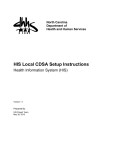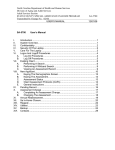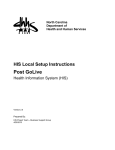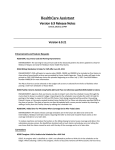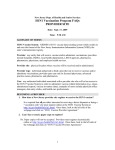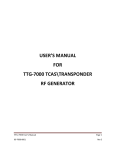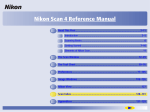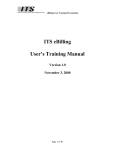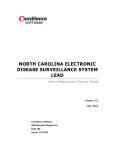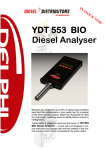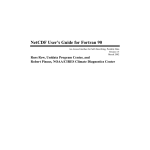Download Local Setup Instructions-Now through Go Live Tasks for LHD 070110
Transcript
North Carolina Department of Health and Human Services HIS Local Setup Instructions Health Information System (HIS) Version 7.1 Prepared By: HIS Project Team – Business Support Group July 1, 2010 HEALTH INFORMATION SYSTEM (HIS) HIS Local Setup Instructions Change History Version Date Version Description V1.0 – June 20, 2008 Original document. V2.0 – November 3, 2008 Tested version. V3.0 – January 26, 2009 Updated based on Pilot UAT review. V3.1 – February 12, 2009 Updated based on Netsmart review V3.2 – February 16, 2009 Guarantor Information updated. V3.3 – April 6, 2009* Removed Appendix E, List of Guarantors/Payors Available in HIS V4.0 – February 1, 2010 Reorganized document to include only local set up tasks grouped under “now” and “8 weeks” out. V5.0 – February 26, 2010 Included 1 week through GoLive tasks tasks. V5.1 – March 30, 2010 Updated screenshot V5.2 - April 7, 2010 Note added to 1 week tasks: User Role and Extended Chart. V5.3 - 4/12/2010 Setup site specific Extended Chart V5.3 - 4/29/2010 District setup notes added. V6.0 - May 13, 2010 Adding a second CLIA number to HIS. V7.0 - June 9, 2010 Update based upon feedback from RSGs. V7.1 - July 1, 2010 Updated the NCID section. Your PHLive environment and How To document screenshots may not always match due to the dynamic nature of HIS. If any modification to the system impacts the process outlined in this document, an updated How To document will be available through the HIS Website. Local Setup Instructions - Now through GoLive Tasks for LHD 070110.doc Page 2 of 82 HEALTH INFORMATION SYSTEM (HIS) HIS Local Setup Instructions This Page Was Intentionally Left Blank. Local Setup Instructions - Now through GoLive Tasks for LHD 070110.doc Page 3 of 82 HEALTH INFORMATION SYSTEM (HIS) HIS Local Setup Instructions Table of Contents 1. INTRODUCTION ...............................................................................................................................................5 1.1 HIS CUSTOMER SUPPORT CONTACT INFORMATION .......................................................................................5 1.2 WORK STATION SET UP .................................................................................................................................5 1.3 NCID .............................................................................................................................................................6 1.3.1 NCID Access Instructions......................................................................................................................6 1.4 HIS USER ROLES ............................................................................................................................................6 1.5 LOGIN TO HIS TRAINING ENVIRONMENT .......................................................................................................7 1.6 LOGIN TO YOUR PHLIVE ENVIRONMENT ........................................................................................................8 1.7 DISTRICT SETUP INFORMATION ......................................................................................................................8 2. SETUP TASKS - NOW .......................................................................................................................................9 2.1 2.2 2.3 2.4 2.5 2.6 2.7 2.8 3. VERIFY PROGRAM CODES WITHIN YOUR ROOT SYSTEM CODE ....................................................................11 VERIFY DICTIONARY VALUE – TYPE OF DOCUMENTATION USED TO VERIFY INCOME.................................13 VERIFY DICTIONARY VALUE – TYPE OF CONSENT .......................................................................................15 VERIFY DICTIONARY VALUE – SERVICE SITE (ENCOUNTER RECORDING)....................................................16 DEFINE REFERRAL SOURCES ........................................................................................................................19 VERIFY CASE LOAD TYPE ............................................................................................................................20 PREPARE DUNNING MESSAGE ......................................................................................................................21 CURRENT PAYORS BILLED ...........................................................................................................................21 SETUP TASKS – ONE (1) WEEK...................................................................................................................22 3.1 UPDATE AGENCY’S FACILITY DEFAULT INFORMATION .................................................................................23 3.2 ENTER LHD SYSTEM DEFAULTS ..................................................................................................................24 3.3 VERIFY AND ASSIGN SERVICE PROGRAMS TO YOUR LOCAL AGENCY ..........................................................26 3.3.1 Deactivate Programs ...........................................................................................................................29 3.4 ASSIGN SERVICE CODES TO EACH PROGRAM ...............................................................................................30 3.5 SETUP SITE SPECIFIC EXTENDED CHART ........................................................................................................34 3.5.1 Manual Chart Number Setup ...............................................................................................................41 3.6 VERIFY CONVERTED PRACTITIONERS...........................................................................................................43 3.7 VERIFY SERVICE FEES ..................................................................................................................................45 3.8 VERIFY CLINICS TRANSFERRED FROM HSIS TO HIS .....................................................................................47 3.9 ASSIGN USER ROLES ....................................................................................................................................48 3.10 ASSOCIATE APPROPRIATE USERS AS PRACTITIONERS ..................................................................................51 3.11 VERIFY CONVERTED SLIDING FEE SCALE ....................................................................................................55 3.12 ADD MEDICAID GUARANTOR/PROGRAM BILLING DEFAULTS (LHD) ..........................................................59 3.13 ADD COMMERCIAL GUARANTOR/PROGRAM BILLING DEFAULTS (LHD) .....................................................60 3.14 CREATE AND UPDATE LAB DICTIONARY TABLES.........................................................................................61 3.15 ENTER CLIA NUMBERS................................................................................................................................62 3.15.1 Enter a Second CLIA Number..............................................................................................................66 3.16 ENTER SYSTEM SELF PAY DUNNING MESSAGES ..........................................................................................67 3.17 ADD EDUCATIONAL MATERIALS ..................................................................................................................69 3.18 ADD NEW OUTGOING REFERRAL SOURCE....................................................................................................71 4. SETUP TASKS – WEEKEND BEFORE GOLIVE .......................................................................................73 4.1 4.2 CLOSE TRANSACTION CONTROL DATE .........................................................................................................73 DEFINE RECEIPT NUMBER DEFINITION (OPTIONAL).....................................................................................74 Local Setup Instructions - Now through GoLive Tasks for LHD 070110.doc Page 4 of 82 HEALTH INFORMATION SYSTEM (HIS) HIS Local Setup Instructions 4.3 4.4 5. VERIFY CONVERTED APPOINTMENTS ...........................................................................................................76 VALIDATE CROSS EPISODE FINANCIAL ELIGIBILITY ....................................................................................76 SETUP TASKS – GOLIVE ..............................................................................................................................78 5.1 ENTER NEW PRACTITIONERS ........................................................................................................................78 APPENDIX A – VERIFICATION FORM..............................................................................................................81 APPENDIX B – REFERRAL SOURCE .................................................................................................................82 1. Introduction The purpose of this document is to assist local health departments (LHDs) and Children’s Developmental Service Agencies (CDSAs) in setting up and maintaining their root system code within the Health Information System (HIS) options. NOTE: Please note that this document will be organized into task groupings depending upon the timeframe in which the tasks need to occur. 1.1 HIS Customer Support Contact Information For all HIS questions and support needs, please contact the DHHS Customer Support Center (CSC). You can reach the DHHS CSC Monday through Friday, 8:00 am through 5:00 pm at: Phone: (919) 855-3200 and select Option 5 Email: [email protected] 1.2 Work Station Set Up Refer to the HIS Website for the minimum desktop requirements to support HIS. This information can be found by accessing the System Requirements folder and then selecting the HIS System Requirements document. The HIS Project Team has worked to identify the highest and lowest versions of JAVA that an agency can run for HIS to work successfully. The lowest version an agency can run is JAVA v1.5_8. The recommended JAVA version is v1.5_12. If you have a JAVA version higher then 5.0 update 12, your System Administrators will need to install the JAVA Runtime Fix Applet. Additional Java instructions are available on the HIS Website under the HIS System Requirements page. Whenever changes are made in the system requirements, the HIS Website will be updated. It is recommended to reference this resource often for updates. Local Setup Instructions - Now through GoLive Tasks for LHD 070110.doc Page 5 of 82 HEALTH INFORMATION SYSTEM (HIS) HIS Local Setup Instructions 1.3 NCID The North Carolina Identity Service (NCID) is the standard identity management and access service provided to state, local, business and citizen users by the Office of Information Technology Services. HIS requires all users to have a NCID to login to the application. Furthermore, you are required to obtain a pre-production NCID to access the HIS training environment. For each Root System Code (RSC), you will have: HIS Live Environment HIS Training Environment (i.e., Sandbox) This is the live HIS environment that you will use to manage business processes within your agency, such as billing and client data. Use your NCID username and NCID password to access this environment. This is a practice environment where you can practice and interact with Avatar without impacting actual client data. Use your pre-production NCID username and preproduction NCID password to access this environment. 1.3.1 NCID Access Instructions For instructions on obtaining a NCID or pre-production NCID, please refer to the NCID Registration Instruction document located on the HIS Website (http://his.dhhs.state.nc.us) under Training & System Manuals > Supplemental Documentation. Please note that it can take up to 30 days to receive a NCID approval. NOTE: If you have staff who currently have a NCID since they access other systems in production (e.g., NCIR), those staff members do not need to acquire a new NCID. Once you establish your NCID username and password, the password associated with your NCID will expire every 90 days. Once your password has expired, your account will be inactivated and you will be required to contact OITS to reactivate your account. An expired password/NCID account will prevent you from logging into HIS. You should receive a notification via email that your password is about to expire. Once you receive this password, make sure you access the NCID website and change your password. 1.4 HIS User Roles Every user who accesses the Avatar system will be assigned a User Role by your local system administrator. The user role to which you are assigned will be tied to the type of job or function you provide within your agency. User roles dictate what you have access to in the Avatar system, which dictates the type of functionality available to you. HIS user roles for both LHD and CDSA agencies can be found on the HIS Website (Training & System Manuals > Supplemental Documentation): HIS User Roles for LHDs HIS User Roles for CDSAs Local Setup Instructions - Now through GoLive Tasks for LHD 070110.doc Page 6 of 82 HEALTH INFORMATION SYSTEM (HIS) HIS Local Setup Instructions 1.5 Login to HIS Training Environment When logging into the HIS Training Environment (i.e., Sandbox), you will need to obtain a preproduction NCID username and password. NOTE: The Training environment is where you will address the Now tasks. For the remaining tasks, you will address these items in your PHLive environment. 1. Enter the following web address: https://his-uats.dhhs.state.nc.us/radplus/index.jsp 2. Once the application opens in your web browser, click the User Authentication link located on the left-hand side of the application. Figure 1: Login Screen for PH Train. 3. Click the PH Train link to enter the HIS Training Environment. NOTE: You will be directed to the Login screen, which requires you to include your System Code, User ID and Password. 4. Enter your Root System Code into the System Code field. 5. Enter your NCID pre-production username in the User ID field. Local Setup Instructions - Now through GoLive Tasks for LHD 070110.doc Page 7 of 82 HEALTH INFORMATION SYSTEM (HIS) HIS Local Setup Instructions 6. Enter your NCID pre-production password in the Password field. NOTE: All three fields are required. Once data is included in all three fields, the Login button will become active. Figure 2: User Authentication screen. 1.6 Login to your PHLive Environment When logging into your PHLive Environment (i.e., Production), you will need a NCID username and password. NOTE: The PHLive environment is where you will address all remaining tasks (tasks that occur after the Now tasks). 1. Enter the following web address: https://his-prod.dhhs.state.nc.us/radplus/index.jsp 2. Once the application opens in your web browser, click the User Authentication link located on the left-hand side of the application. 3. Enter your Root System Code into the System Code field. 4. Enter your NCID username in the User ID field. 5. Enter your NCID password in the Password field. NOTE: All three fields are required. Once data is included in all three fields, the Login button will become active. 1.7 District Setup Information Within the document, district setup notes are provided within an orange text block. When a task is noted to be setup at the District level, this indicates that the user needs to log in to HIS using their 200 level Root System Code (RSC) in the System Code field. When a task is noted to be setup at the Sub-RSC level, this indicates that the user needs to log in to HIS using their 100 level Root System Code (RSC) in the System Code field, unless otherwise noted. Local Setup Instructions - Now through GoLive Tasks for LHD 070110.doc Page 8 of 82 HEALTH INFORMATION SYSTEM (HIS) HIS Local Setup Instructions 2. Setup Tasks - Now The following tasks can be addressed now. For tasks that occur within HIS, you will tackle these tasks in your local PHTrain environment, unless otherwise noted. Use this page to check off completed activities. NOTE: The Training environment is where you will address the Now tasks. For all tasks not grouped under the Now heading, they will be addressed in your PHLive environment. Task Associated Instruction(s) Address work denials, negative balances and write-offs before GoLive so that you bring only positive patient balances forward. Verify that everyone in your agency that will be using HIS has NCID a NCID. Note: Your local NCID administrator will need to perform this task. This task is a priority as a NCID is required to access the system. It may take up to 30 days to obtain a NCID. Designate an individual to verify the list of program codes 2.1 Verify Program Codes within your specific root system code(s). within your Root System Code Complete Appendix A to verify that the information is complete and is what you want moved into Production so that your agency will be ready to use these fields on your GoLive date; the form should be submitted no later than 4 weeks before your GoLive date. Designate an individual within your Root System Code to validate the dictionary values for Type of Documentation field for verifying type of income is complete and accurate. Complete Appendix A to verify that the information is complete and is what you want moved into Production so that your agency will be ready to use these fields on your GoLive date; the form should be submitted no later than 4 weeks before your GoLive date. Designate an individual within your Root System Code to validate the Type of Consent dictionary values found within the Consents/Authorization/Notification option. Complete Appendix A to verify that the information is complete and is what you want moved into Production so that your agency will be ready to use these fields on your GoLive date; the form should be submitted no later than 4 weeks before your GoLive date. Designate an individual within your Root System Code to validate the dictionary values for the Service Site cell within the Encounter Recording option. Prepare the following on paper, but do not enter at this time the information on Referral Sources used by your agency. Local Setup Instructions - Now through GoLive Tasks for LHD 070110.doc 2.2 Verify Dictionary Value – Type of Documentation Used to Verify Income 2.3 Verify Dictionary Value – Type of Consent 2.4 Verify Dictionary Value – Service Site (Encounter Recording) 2.5 Define Referral Sources See Referral Source Page 9 of 82 HEALTH INFORMATION SYSTEM (HIS) HIS Local Setup Instructions Look at the required fields for this in the system and have that information on your referral sources ready to go so it can be quickly entered. Verify Case Load Types available in your Root System Code. Prepare dunning message on paper. Submit to the HIS Project Team a list of current Payors billed in the last three (3) months. Local Setup Instructions - Now through GoLive Tasks for LHD 070110.doc Management section within the HIS User Manual. Location: HIS Website > HIS Manual > Referral Source Maintenance 2.6 Verify Case Load Type 2.7 Prepare Dunning Message See Client Self Pay Dunning Message section within the HIS User Manual. Location: HIS Website > HIS Manual > Client Management 2.8 Current Payors Billed HIS Website > Training & System Manuals > Supplemental Documentation > Commercial Guarantor HIS Website > Training & System Manuals > Forms > HIS Request Form Page 10 of 82 HEALTH INFORMATION SYSTEM (HIS) HIS Local Setup Instructions 2.1 Verify Program Codes within your Root System Code Review and verify the program codes identified within the Program Maintenance option. District Setup Note: This task should be handled at the District RSC level (i.e., 200 level RSC). Avatar Path: Avatar PH > System Maintenance > System Definition > Program Maintenance Figure 3: System Definition – Program Maintenance Tab. 1. Select the Program Maintenance tab. 2. Click on the Print All Programs button to display the All Programs Report. NOTE: This report will take a few moments to display. NOTE To print all programs, no data entry is required. Local Setup Instructions - Now through GoLive Tasks for LHD 070110.doc Page 11 of 82 HEALTH INFORMATION SYSTEM (HIS) HIS Local Setup Instructions 3. Review the All Programs Report. Sample Report Figure 4: Example of All Programs Report. NOTE Once you have completed this review, include your comments within Appendix A and submit the document to the HIS Team no later than four (4) weeks prior to your GoLive date. Local Setup Instructions - Now through GoLive Tasks for LHD 070110.doc Page 12 of 82 HEALTH INFORMATION SYSTEM (HIS) HIS Local Setup Instructions 2.2 Verify Dictionary Value – Type of Documentation Used to Verify Income Review and verify the Type of Documentation field located within the Client Household/Contract Information option. District Setup Note: This task should be handled at the District RSC level (i.e., 200 level RSC). Avatar Path: Avatar PH > Client Management > Client Information > Client Household/Client Information Figure 5: Client Household/Client Information – Client Information tab. 1. Select the Household/Contact Information tab. 2. Click Add New Item button. NOTE: In order to verify the values within the Type of Documentation field, which is located within the Income Verification tab, you must first establish a “client” within the Client Contact Information multi-iteration table. If you do not select the Add New Item button, when you select the Income Verification tab, you will receive an error message. Figure 6: Client Household/Client Information – Household/Contact Information tab. 3. Select the Income Verification tab. Local Setup Instructions - Now through GoLive Tasks for LHD 070110.doc Page 13 of 82 HEALTH INFORMATION SYSTEM (HIS) HIS Local Setup Instructions 4. Select the Type of Documentation drop-down list and verify the values listed are correct. NOTE: Once you are finished reviewing this dictionary value, close out of this option; do not save or submit your changes. Figure 7: Client Household/Client Information – Income Verification tab. NOTE Once you have completed this review, include your comments within Appendix A and submit the document to the HIS Team no later than four (4) weeks prior to your GoLive date. Local Setup Instructions - Now through GoLive Tasks for LHD 070110.doc Page 14 of 82 HEALTH INFORMATION SYSTEM (HIS) HIS Local Setup Instructions 2.3 Verify Dictionary Value – Type of Consent Review and verify the Type of Consent field values located within the Consents/Authorizations/Notifications option. District Setup Note: This task should be handled at the District RSC level (i.e., 200 level RSC). Avatar Path: Avatar PH > Client Management > Registration and Enrollment > Consents/Authorizations/Notifications Figure 8: Consents/Authorizations/Notifications – Comments tab. 1. 2. Select the Consents/Authorizations/Notifications tab. Select the Type of Consent drop-down field and verify the values listed are correct. NOTE: Once you are finished reviewing this dictionary value, close out of this option; do not save or submit your changes. Local Setup Instructions - Now through GoLive Tasks for LHD 070110.doc Page 15 of 82 HEALTH INFORMATION SYSTEM (HIS) HIS Local Setup Instructions Figure 9: Consents/Authorizations/Notifications tab. NOTE Once you have completed this review, include your comments within Appendix A and submit the document to the HIS Team no later than four (4) weeks prior to your GoLive date. 2.4 Verify Dictionary Value – Service Site (Encounter Recording) Review and verify the Type of Consent field values located within the Encounter Recording option. District Setup Note: This task should be handled at the District RSC level (i.e., 200 level RSC). Avatar Path: Avatar PH > Services > Services > Encounter Recording 1. Enter a client in the Client Name/ID# field. 2. Click the OK button to access the Encounter Recording option. NOTE: If no previous encounters exist for the client, you will be directed to the Encounter Recording option. If the client you selected has a prior encounter recorded in the system, you will receive the Pre-Display screen. If you receive the Pre-Display screen for Encounter Recording, click the Add button. Local Setup Instructions - Now through GoLive Tasks for LHD 070110.doc Page 16 of 82 HEALTH INFORMATION SYSTEM (HIS) HIS Local Setup Instructions 3. Enter a date in the Encounter Recording field. NOTE: In order to access the Encounter Charge Input grid, you have to include data in the required fields within the Encounter Information tab. Figure 10: Encounter Date field and Diagnosis 1 field. 4. Enter a diagnosis in the Diagnosis 1 field (see Figure 10). NOTE: In order to access the Encounter Charge Input grid, you have to include at least one medical diagnosis. You can enter V20.2 in the Diagnosis 1 field. The actually diagnosis entered is not important, only that a diagnosis is entered. 5. Click the Process Search button (see Figure 10). NOTE: If you entered the complete diagnosis, a “Confirm” dialog box will display. Click the OK button to continue. If you entered a portion of the diagnosis code, you will need to select a diagnosis code from the Diagnosis 1 drop-down field. 6. Click the Launch Encounter Charge Input button. The Encounter Charge Input grid displays. Figure 11: Launch Encounter Charge Input button 7. Using the horizontal scroll bar, locate the Service Site field. Local Setup Instructions - Now through GoLive Tasks for LHD 070110.doc Page 17 of 82 HEALTH INFORMATION SYSTEM (HIS) HIS Local Setup Instructions 8. Double-click the Service Site field. NOTE: The Service Site search results dialog box displays. Review the service sites listed in this dialog box. Once you are finished reviewing the available service sites, close out of this option; do not save or submit your changes. Figure 12: Encounter Charge Input – Service Site field and Service Site search results dialog box. NOTE If you identify that a service site is not listed, please contact the HIS Help Desk for assistance with adding additional service sites. Local Setup Instructions - Now through GoLive Tasks for LHD 070110.doc Page 18 of 82 HEALTH INFORMATION SYSTEM (HIS) HIS Local Setup Instructions 2.5 Define Referral Sources If needed, you can define referral sources in the Avatar system for your agency. Prepare the following on paper, but do not enter this information into the Avatar system. Look at the required fields for this in the system and have that information on your referral sources ready to go so it can be quickly entered. District Setup Note: This task occurs outside of HIS. The HIS Project Team recommends maintaining one spreadsheet with your referral sources. NOTE: Appendix B is provided to help you capture referral source information. Replicate Appendix B for each referral source you need entered into Avatar. Figure 13: Referral Source Maintenance option Local Setup Instructions - Now through GoLive Tasks for LHD 070110.doc Page 19 of 82 HEALTH INFORMATION SYSTEM (HIS) HIS Local Setup Instructions 2.6 Verify Case Load Type Review and verify the Case Load Type field values located within the Caseload Type Maintenance option. District Setup Note: This task should be handled at the local level (i.e.., by each Sub-Root System Code). Avatar Path: Avatar PH > System Maintenance > System Definition > Caseload Type Maintenance Figure 14: Caseload Type Maintenance option 1. Click the Select Existing Caseload Type button. NOTE: The Select Existing Caseload Type dialog box displays. Figure 15: Select Existing Caseload Type dialog box 2. Verify the Caseload Type list is accurate. NOTE: If any Caseload Types are missing and need to be added, please contact your State HIS Administrative Consultant or the HIS Project Team 919-855-3200 option 5 or 919-218-3867. Local Setup Instructions - Now through GoLive Tasks for LHD 070110.doc Page 20 of 82 HEALTH INFORMATION SYSTEM (HIS) HIS Local Setup Instructions 2.7 Prepare Dunning Message District Setup Note: This task occurs outside of HIS. The recommendation is that a single dunning message be provided across all Sub-Root System Codes. Prepare the following on paper, but do not enter at this time the dunning messages you would like to be printed on Self-Pay client bills/statements. Note that there is an 80 character limit on each field, so it may take some time to create the applicable wording due to the character restrictions. Please refer the HIS User Manual for additional Client Self Pay Dunning Message information. Client Self Pay Dunning Message information can be found in the PH System Maintenance chapter. The User Manual is located on the HIS Website (Training & System Manuals > HIS Manual). 2.8 Current Payors Billed On the HIS Website (Training & System Manuals > Supplemental Documentation > Commercial Guarantor), we have provided a list of all Commercial Guarantors currently in the Avatar system. Please review the document and verify that all Payors your agency has billed are listed in the spreadsheet. If not, please complete the HIS Request Form, which is located on the Forms page. The HIS Request Form (HIS Website > Training & System Manuals > Forms > HIS Request Form) provides your agency with the mechanism and instructions for communicating additions or changes to guarantors listed in your RSC. Submit the HIS Request Form no later than 4 weeks before your GoLive date to: - HIS Team, MSC 1919, Raleigh, NC 27699-1919; or - via fax to (919) 870-4851 Local Setup Instructions - Now through GoLive Tasks for LHD 070110.doc Page 21 of 82 HEALTH INFORMATION SYSTEM (HIS) HIS Local Setup Instructions 3. Setup Tasks – One (1) Week The following tasks will be addressed by your agency 1 week prior to your GoLive date in your PHLive environment, unless otherwise noted. Do not modify data in your PHLive RSC if you were asked to verify a data conversion task. Your objective is to verify that the data conversion properly occurred for that item. The data conversion process is a two part process and making changes to certain items in your PHLive environment can negatively impact the entire data conversion process. For those tasks in this grouping that is not a “verify” task, you can enter information into your PHLive environment specific to that task. Use this page to check off the completed activity. District Setup Note: The HIS Project Team recommends that the billing setup tasks below be handled at the District level. The primary reason for this recommendation centers on the fact that all 835s returned will be posted at the District RSC level. Each Sub-RSC can prepare and send out multiple 837 files; however, the District will ONLY get 1 835 back that must be posted at the district level. Your agency will find the process much easier if one person at the district level manage the entire 837-835 process. Task(s) Update your agency’s facility default information Enter LHD System Defaults Verify and assign service programs to your local agency. Assign service codes to each program. Setup site specific extended chart (i.e., system generated chart numbers). Verify converted practitioners. Verify service fees. Verify that clinics in HSIS transferred to HIS. NOTE: Do not add clients to your clinics if clinics are added. Client data entry should occur after Data Conversion 2 only. Assign user roles. Associate appropriate users as practitioners. Verify converted sliding fee scale. Associated Instruction(s) 3.1 Facility Defaults 3.2 LHD System Defaults 3.3 Verify and assign Service Program to Agency 3.4 Assign Service Codes to Programs 3.5 Setup Site Specific Charts Add Medicaid Guarantor/Program Billing Defaults (LHD). Add Commercial Insurance Guarantor/Program Billing Defaults (LHD). Create and updated lab dictionary tables. Enter Clinical Laboratory Improvements Amendment (CLIA) Number Local Setup Instructions - Now through GoLive Tasks for LHD 070110.doc 3.6 Verify converted practitioners 3.7 Verify service fees 3.8 Verify clinics transferred from HSIS to HIS 3.9 Assign user roles 3.10 Associate user as practitioner 3.11 Verify SFS 3.12 Add Medicaid Guarantor/Program Billing defaults 3.13 Add Commercial Insurance Guarantor/Program Billing defaults 3.14 Create / update lab dictionary tables 3.15 Enter CLIA Number Page 22 of 82 HEALTH INFORMATION SYSTEM (HIS) HIS Local Setup Instructions Enter system Self-Pay Dunning Message. Add educational materials. Add new referral sources. 3.16 Enter Self-Pay Dunning Message 3.17 Add educational materials 3.18 Add new referral source 3.1 Update agency’s facility default information Use the Facility Defaults option to set your agency’s default information for paper and electronic billing. If your default information is not correct, you may update the information at this point. This task should occur after data conversion 1. District Setup Note: This task should be handled at the District RSC level (i.e., 200 level RSC). Avatar Path to Facility Defaults: Avatar PH > System Maintenance > System Definition > Facility Defaults Figure 16: Facility Defaults option Local Setup Instructions - Now through GoLive Tasks for LHD 070110.doc Page 23 of 82 HEALTH INFORMATION SYSTEM (HIS) HIS Local Setup Instructions 1. Verify only the fields on the left side of the Facility Defaults tab. NOTE: The information on the right side of the Facility Defaults tab will be pre-populated with information from data conversion. Do not enter/modify any information on the right side of the Facility Defaults tab. 2. Correct any information that is not accurate. 3. Click Submit to save your facility default information. 3.2 Enter LHD System Defaults Use the Set System Defaults option to set your agency’s default information as it will appear in report titles and general system setup options. District Setup Note: This task should be handled at the Sub-RSC level (i.e., 100 level RSCs). Make sure that when performing this step you login to the Sub-RSC. Avatar Path to Set System Defaults: Avatar CWS > CWS Utilities > Set System Defaults Figure 17: Set System Defaults 1. 2. 3. 4. Enter the agency’s name in the Report Title Line 1 field. Enter the agency’s city in the Report Title Line 2 field. Enter North Carolina in the Report Title Line 3 field. For Progress Notes Setup do the following: a. In the Disable Progress Notes of Type field select the checkbox for Existing Local Setup Instructions - Now through GoLive Tasks for LHD 070110.doc Page 24 of 82 HEALTH INFORMATION SYSTEM (HIS) HIS Local Setup Instructions Appointment and New Service to disable this type of progress notes. b. Select Yes in the Restrict Progress notes to Active Episodes field. c. Select all options in the Disable The Selection of the Following Treatment Plan Types field. CAUTION! Do not make any selection for the Update Treatment Plan Type Selections To Match The Site Specific Tab Description For Tab 1 Of The Option field. 5. Click the Submit button . Local Setup Instructions - Now through GoLive Tasks for LHD 070110.doc Page 25 of 82 HEALTH INFORMATION SYSTEM (HIS) HIS Local Setup Instructions 3.3 Verify and Assign Service Programs to your Local Agency During data conversion 1, programs specific to your agency will be transferred to HIS. This task requires you to validate that the all applicable programs transferred. If a program did not transfer or a program needs to be added, you can follow the steps below to add additional programs. All service codes must be associated with a Service Program. . District Setup Note: This task should be handled at the District RSC level (i.e., 200 level RSC). You must repeat the steps within this section for each Sub-RSC within your District. Avatar Path: Avatar PH >> System Maintenance >> System Definition >> Program Maintenance Figure 18: Program Maintenance Tab. 1. Select Edit in the Add Or Edit Program field. Local Setup Instructions - Now through GoLive Tasks for LHD 070110.doc Page 26 of 82 HEALTH INFORMATION SYSTEM (HIS) HIS Local Setup Instructions 2. Select the PHRSC – local agency program in the Program drop-down field. NOTE: Look for the program that reads “PH + Root System Code – Agency” from the Program drop-down field. For Districts, you will have more than one PH+RSC available. 3. In the Associated Service Program field, verify that all applicable programs are selected. NOTE: Programs will be carried over from HSIS to HIS regardless if the programs are active or not active. If a program is active and not selected in the Associated Service Program field, you may select the checkbox next to the program name before submitting changes. NOTE: If no programs are selected, check all programs that are applicable for the Sub-RSC. Note that Health Check is a program. If your agency provides Health Check services, you will need to select the program, too. This is tied to the billing functionality within HIS. 4. Enter your agency’s Federal Tax ID in the Program Tax ID field. 5. Enter the street address in the Program Address – Street field. 6. Click the Forward button to Page 2. Figure 19: Program Maintenance – Page 2 7. Enter the sub-RSC’s zipcode in the Program Address – Zipcode field. NOTE: Tab out of this field to automatically populate the city and state fields. 8. Enter the sub-RSC’s telephone number in the Program Phone Number field. 9. Enter the sub-RSC’s fax number in the Program Fax Number field. Local Setup Instructions - Now through GoLive Tasks for LHD 070110.doc Page 27 of 82 HEALTH INFORMATION SYSTEM (HIS) HIS Local Setup Instructions 10. Click the Forward button to Page 3 and verify that Yes is selected in the Allow Charge Entry field. Figure 20: Allow Charge Entry field 11. Select the Assign Services To Program tab (see Figure 21). 12. Verify that the (00000) All Service Codes checkbox (i.e., first checkbox) in the Services field is selected. NOTE: If this checkbox is not selected, you may select the checkbox. This action allows all services codes to be associated to the selected Root System Code. Figure 21: Allow Charge Entry field Local Setup Instructions - Now through GoLive Tasks for LHD 070110.doc Page 28 of 82 HEALTH INFORMATION SYSTEM (HIS) HIS Local Setup Instructions 13. Select the Program Maintenance tab and click the Back button to return to Page 1. 14. Click the File Program button. DISTRICT NOTE: Repeat this process for all sub-RSCs within your District. 3.3.1 Deactivate Programs If a program converted from HSIS to HIS is selected as an active program, you can deactivate the program at this point. Please note that you can only deactivate one program at a time. If you are a District, this process will need to be repeated for all sub-RSCs within your District. For Districts, you will need to log-in to your Sub-RSC to delete the program from the sub-RSC. 1. Select Edit in the Add Or Edit Program field. 2. Select the appropriate program from the Program drop-down field. NOTE: Adult Health is selected as an example only. Select the program that requires inactivation from the Program drop-down field. Figure 22: Deactivate a program 3. Select No in the Active field. 4. Click the File Program button. Local Setup Instructions - Now through GoLive Tasks for LHD 070110.doc Page 29 of 82 HEALTH INFORMATION SYSTEM (HIS) HIS Local Setup Instructions 3.4 Assign Service Codes to Each Program District Setup Note: This task should be handled at the District RSC level (i.e., 200 level RSC) to ensure that the appropriate service codes are associated with the programs provided within your District. However, you will need to login to each Sub-RSC to perform the steps listed in this section. The steps in this section must be completed for each Sub-RSC. All facility programs must have Service Codes assigned to their Service Program individually. If a Service Program has no assigned Service Codes, then no services are available for selection in the Services field on the Assign Services To Program tab. This task must occur after Data Conversion 1. NOTE: If a needed Service Code is not listed in the Services field, complete the HIS Request Form. This form is located on the HIS Website (Training & System Manuals > Forms > HIS Request Form). Complete the necessary information and submit the form to the HIS Project Team. Avatar Path to Program Maintenance: Avatar PH >> System Maintenance >> System Definition >> Program Maintenance Figure 23: System Definition - Program Maintenance Tab. Local Setup Instructions - Now through GoLive Tasks for LHD 070110.doc Page 30 of 82 HEALTH INFORMATION SYSTEM (HIS) HIS Local Setup Instructions 1. Select the Edit radio button while in Program Maintenance tab. 2. Select a service program from the Program drop-down field. NOTE: In Figure 23, Tuberculosis is selected as an example. This process will need to be replicated for all service programs. 3. Select Yes in the Active field. 4. Click the Forward button to Page 3. NOTE: No information is required on Page 2 of the Program Maintenance tab. 5. On Page 3, Verify that Yes is selected in the Allow Charge Entry field. Figure 24: Allow Charge Entry Local Setup Instructions - Now through GoLive Tasks for LHD 070110.doc Page 31 of 82 HEALTH INFORMATION SYSTEM (HIS) HIS Local Setup Instructions 6. Select the Assign Services To Program tab. NOTE: Within this tab, a list of possible services for the selected program will be available. Figure 25: System Definition - Program Maintenance Tab. Local Setup Instructions - Now through GoLive Tasks for LHD 070110.doc Page 32 of 82 HEALTH INFORMATION SYSTEM (HIS) HIS Local Setup Instructions 7. In the Services field, select the services that are associated with the selected program. NOTE: Refer to your HSIS Service Codes by Program report, SERVICE CODES – CNTY### or SERVICE CODES – DIST##. Figure 26: Example of All Programs Report. 8. Select the Program Maintenance tab. Back button and return to Page 1 of the Program Maintenance tab. 9. Click the 10. Click the File Program button. NOTE: The Service Code is now assigned to the Service Program. 11. Repeat the steps in this section to assign the applicable service codes to each program. For Districts: Log out of the Sub-RSC and log back in to the next Sub-RSC and repeat this task for that Sub-RSC. Local Setup Instructions - Now through GoLive Tasks for LHD 070110.doc Page 33 of 82 HEALTH INFORMATION SYSTEM (HIS) HIS Local Setup Instructions 3.5 Setup site specific extended chart District Setup Note: This task should be handled at the local level (i.e., 100 level RSCs). You must repeat the steps within this section for each Sub-RSC within your District. The system can be setup to automatically generate chart numbers for your local agency. The system provides a few options related to generating chart numbers. The setup steps will depend upon the chart numbering format determined by your local agency. This task must occur after Data Conversion 1. NOTE: If you do not want the system to automatically number your charts; however, you want to manually enter the chart number for your clients, refer to the manual chart number setup section. NOTE For clients that have a chart number assigned to them in HSIS, when you use the Generate Chart Number option in HIS, the converted chart number should display. It is up to the local agency to determine how they will manage chart numbers in HIS using the parameters available within the system. Avatar Path: Avatar PH > System Maintenance > System Definition > Program Maintenance Local Setup Instructions - Now through GoLive Tasks for LHD 070110.doc Page 34 of 82 HEALTH INFORMATION SYSTEM (HIS) HIS Local Setup Instructions Figure 27: Program Maintenance 1. Select Edit in the Add Or Edit Program field. 2. Select your PHRSC (PH+Root System Code) from the Program drop-down field. NOTE: Districts will have multiple PHRSC; therefore, Districts will need to repeat this process for each county that would like HIS to generate chart numbers. 3. Select the Site Specific Extended Dictionaries tab. NOTE: As you set up each variable, the Defined Extended Dictionary Values field (located on the Site Specific Extended Dictionaries tab) will reflect the generated chart number parameters established as you complete the steps below. Local Setup Instructions - Now through GoLive Tasks for LHD 070110.doc Page 35 of 82 HEALTH INFORMATION SYSTEM (HIS) HIS Local Setup Instructions Figure 28: Site Specific Extended Dictionaries tab 4. If applicable, select (60100) Chart Numbering Defaulting from the Extended Dictionary Data Element drop-down field. NOTE: Selecting this value will determine what values populate in the Extended Dictionary Value (Single Dictionary) drop-down field, which determines whether a sequential chart number is automatically generated or manually entered and, if auto-generated, whether it is editable. Local Setup Instructions - Now through GoLive Tasks for LHD 070110.doc Page 36 of 82 HEALTH INFORMATION SYSTEM (HIS) HIS Local Setup Instructions 5. If you do perform step 4, select the appropriate option from the Extended Dictionary Value (Single Dictionary) drop-down field. Option None Sequential (Locked) Sequential Action System will not provide chart number automatically. System generates your local agency’s chart numbers; the chart numbers are not editable. System generates your local agency’s chart numbers; the chart numbers are editable. Figure 29: Site Specific Extended Dictionaries tab 6. If applicable, select (60101) Chart Number Prefix from the Extended Dictionary Data Element drop-down field. Local Setup Instructions - Now through GoLive Tasks for LHD 070110.doc Page 37 of 82 HEALTH INFORMATION SYSTEM (HIS) HIS Local Setup Instructions 7. If you perform step 6, enter your chart number prefix in the Extended Dictionary Value (Free Text) field. NOTE: This is a 10 character alphanumeric value that will succeed the numeric portion of the chart number. Using this option is determined and defined by the local agency. For example, if you entered 2010 in the Extended Dictionary Value (Free Text) field, your chart numbers would start with 2010. Figure 30: Site Specific Extended Dictionaries tab 8. If applicable, select (60102) Chart Number Suffix from the Extended Dictionary Data Element drop-down field. NOTE: This is a 10 character alphanumeric value that will succeed the numeric number. Using this option is determined and defined by the local agency. 9. If you perform step 8, enter your chart number suffix in the Extended Dictionary Value (Free Text) field. Example: If you enter 2010 in the Extended Dictionary Value (Free Text) field, all chart number would end with 2010. Local Setup Instructions - Now through GoLive Tasks for LHD 070110.doc Page 38 of 82 HEALTH INFORMATION SYSTEM (HIS) HIS Local Setup Instructions 10. If applicable, select (60103) Chart Number Leading Zeros from the Extended Dictionary Data Element drop-down field. NOTE: This option will display the number of leading zeroes that will be appended when the user generates or enters a chart number using the Generate Chart Number option. 11. If you perform step 10, enter the number of leading zeroes in the Extended Dictionary Value (Free Text) field. NOTE: This will be a number such as “5.” If you entered a 5, your chart numbers will add a specific number of zeros to your chart number until there are five total characters for the chart number (e.g., 00001 or 09000). Leave this field blank if you do not want the system to include leading zeroes. Figure 31: Site Specific Extended Dictionaries tab 12. If applicable, select (60104) Next Available Chart Number from the Extended Dictionary Data Element drop-down field. NOTE: This option will allow the next number to be provided to the chart. If you use another number system, this will allow the system to continue the number sequentially from where you left off. Leave this field blank if you want the system to start at 1. Local Setup Instructions - Now through GoLive Tasks for LHD 070110.doc Page 39 of 82 HEALTH INFORMATION SYSTEM (HIS) HIS Local Setup Instructions 13. If you perform step 12, enter the appropriate next number in the Extended Dictionary Value (Free Text) field. Figure 32: Site Specific Extended Dictionaries tab 14. Select the Program Maintenance tab. 15. Click the Back button and return to Page 1. Local Setup Instructions - Now through GoLive Tasks for LHD 070110.doc Page 40 of 82 HEALTH INFORMATION SYSTEM (HIS) HIS Local Setup Instructions 16. Click the File Program button to save the chart numbering settings. Figure 33: Site Specific Extended Dictionaries tab 3.5.1 Manual Chart Number Setup If you completed the steps above for setting up Site Specific Extended Chart, continue to the next task. If your agency would like to manually generate chart numbers for the client instead of having HIS automatically establish the chart numbers, complete these setup steps. 1. Select Edit in the Add Or Edit Program field. 2. Select your PHRSC (PH+Root System Code) from the Program drop-down field. NOTE: Districts will have multiple PHRSC; therefore, Districts will need to repeat this process for each county that would like HIS to generate chart numbers. Local Setup Instructions - Now through GoLive Tasks for LHD 070110.doc Page 41 of 82 HEALTH INFORMATION SYSTEM (HIS) HIS Local Setup Instructions 3. Select the Site Specific Extended Dictionaries tab. Figure 34: Site Specific Extended Dictionaries tab 4. Select (60100) Chart Number Defaulting from the Extended Dictionary Data Element drop-down list. NOTE: This activates the Extended Dictionary Value (Single Dictionary) drop-down list. 5. Select None from the Extended Dictionary Value (Single Dictionary) drop-down list. 6. Select the Program Maintenance tab. 7. Click the Back button and return to Page 1. 8. Click the File Program button to save the chart numbering settings. Local Setup Instructions - Now through GoLive Tasks for LHD 070110.doc Page 42 of 82 HEALTH INFORMATION SYSTEM (HIS) HIS Local Setup Instructions 3.6 Verify Converted Practitioners District Setup Note: Since practitioners may provide services within each sub-RSC, this task should be handled at the District level (i.e., 200 level RSC). This task allows you to verify practitioners converted from HSIS to HIS. If you are required to add a new practitioner, you may do so at this time. You are also able to edit existing practitioner information. However, do not terminate a practitioner using the Practitioner Termination option until after Data Conversion 2 (i.e., the day you go live in HIS). Avatar Path: Avatar PH>Practitioner>Practitioner Information>Practitioner Inquiry Figure 35: Practitioner Information – Practitioner Inquiry 1. 2. 3. 4. Select Practitioner Enrollment from the Practitioner Option drop-down field. Select All in the Individual or All Practitioner field. Enter today’s date in the Inquiry State Date field. Enter today’s date in the Inquiry End Date field. Local Setup Instructions - Now through GoLive Tasks for LHD 070110.doc Page 43 of 82 HEALTH INFORMATION SYSTEM (HIS) HIS Local Setup Instructions 5. Click on the Process button. NOTE: This will generate a report of all the practitioners. Figure 36 is an example of the Practitioner Report that displays all enrolled practitioners. It is not necessary to print this report. Sample Report Figure 36: Sample Practitioner Report 6. Page through the report using the Next >> button. NOTE: Using the Search practitioner. tab, you may also use the search feature to lookup a specific 7. After reviewing the report, click on the View tab and then the Dismiss to the Practitioner Inquiry option. button to return NOTE: If there are data conversion issues identified, such as missing practitioners, please contact your State HIS Administrative Consultant or the HIS Project Team 919-855-3200 option 5 or 919-218-3867. Local Setup Instructions - Now through GoLive Tasks for LHD 070110.doc Page 44 of 82 HEALTH INFORMATION SYSTEM (HIS) HIS Local Setup Instructions 3.7 Verify Service Fees District Setup Note: This task should be handled at the District level (i.e., 200 level RSC) as only one fee for a service should exist. Verify that your agency’s Service Fees have been converted correctly from HSIS to HIS. The HIS Project Team recommends that you contact the Help Desk should you require any modifications to your service fees to ensure that management of your service fees occurs properly in HIS. Avatar Path: Avatar PH > System Maintenance > System Definition > Service Code Maintenance > Service Fee Maintenance Figure 37: Service Code Maintenance – Service Fee Maintenance Tab Local Setup Instructions - Now through GoLive Tasks for LHD 070110.doc Page 45 of 82 HEALTH INFORMATION SYSTEM (HIS) HIS Local Setup Instructions 1. Click on the Service Fee Definition Report button. NOTE: A Service Fee Definition Report will display. Sample Service Fee Definition Report Figure 38: Sample Service Fee Definition Report 2. Review the entire list of fees. NOTE: Use the Next Page arrow button at the top of the window to move forward in the report. 3. If you find any data conversion errors, the HIS Project Team recommends that you contact the Help Desk should you require any modifications to your service fees to ensure that management of your service fees occurs properly in HIS. Please contact the HIS Project Team 919-855-3200 option 5. NOTE: There is a Manage Service Fees and Flat Fees manually using Service Fee Maintenance How to on the HIS Website. However, it is recommended that you contact the Help Desk initially so that we may work with your agency to prepare a worksheet that will allow you to more efficiently manage your service fees in HIS. Local Setup Instructions - Now through GoLive Tasks for LHD 070110.doc Page 46 of 82 HEALTH INFORMATION SYSTEM (HIS) HIS Local Setup Instructions 3.8 Verify clinics transferred from HSIS to HIS District Setup Note: This task should be handled at the local level (i.e., 100 level RSCs) as clinics may vary across Sub-RSCs. NOTE If you are using HSIS for clinic scheduling, do not modify EXISTING clinics as this will impact the client data conversion process. However, you may add NEW clinics to HIS during the 1week setup activity. Please refer to the How to Establish Clinic Sites for Clinic Appointment Scheduling, which is located on the HIS Website > Training & System Manuals > How To Help Guides. If are not using HSIS for clinic scheduling, you may set up clinics. Follow the instructions within How to Establish Clinic Sites for Clinic Appointment Scheduling document. Avatar Path: Avatar PH > Appointment Scheduling > Clinic Scheduling Figure 39: Clinic Scheduling option Local Setup Instructions - Now through GoLive Tasks for LHD 070110.doc Page 47 of 82 HEALTH INFORMATION SYSTEM (HIS) HIS Local Setup Instructions 1. In the Clinic Scheduling option, select the Site drop-down list. 2. Review the clinics listed within the Site drop-down list. 3. Verify the clinics listed are accurate. If any identify any data conversion errors, please contact the HIS Project Team 919-855-3200 option 5 or 919-218-3867. 3.9 Assign User Roles District Setup Note: This task should be handled at the local level (i.e., 100 level RSCs). Before assigning a user role to a HIS user, verify that you have logged in to the applicable sub-RSC that matches the sub-RSC the user will be using. For example, if John Smith will be a user in subRSC 194, the LHD Administrator will need to log in to sub-RSC 194 before assigning John Smith a user role. Enter and assign users to user roles by following the steps in the User Definition option. This option allows you to address one user at a time. NOTE When setting up user roles, the Allow User Role Customization field is active and required. The field will default with No selected. DO NOT select Yes. Customizing your user role can create issues with accessing functionality in the system. Avatar Path: Avatar PH > RADplus Utilities > System Security> User Definition Local Setup Instructions - Now through GoLive Tasks for LHD 070110.doc Page 48 of 82 HEALTH INFORMATION SYSTEM (HIS) HIS Local Setup Instructions Figure 40: System Security – User Definition Tab. 1. Select Login Only in the Associate User To Network ID Through Avatar Identity Manager field. NOTE: Login Only should always be selected. 2. Enter the user’s name in the Select User field. 3. Click the Process Search button. NOTE: If multiple matches display, select the appropriate user from the Select User drop-down field. If the name appears: a. Click on the OK button. This will populate the User ID and User Description fields. If the name is not found, perform a search within NCID to obtain the user’s NCID. a. Enter the approved NCID user name in the User ID field. b. Tab out of the User ID field. The correct user information displays in the User Description field. Local Setup Instructions - Now through GoLive Tasks for LHD 070110.doc Page 49 of 82 HEALTH INFORMATION SYSTEM (HIS) HIS Local Setup Instructions 4. Click the Forward button to access Page 2. 5. In the User Roles(s) field, select the appropriate user role(s) for the user. NOTE: A complete list of user roles can be found on the HIS Website (Training & System Manuals > Supplemental Documentation) for both LHDs and CDSAs. Figure 41: System Security – User Definition Tab 6. Click the Submit button to Save the user role(s) for the identified HIS user. Local Setup Instructions - Now through GoLive Tasks for LHD 070110.doc Page 50 of 82 HEALTH INFORMATION SYSTEM (HIS) HIS Local Setup Instructions 3.10 Associate Appropriate Users as Practitioners District Setup Note: This task should be handled at the local level (i.e., 100 level RSCs). Before assigning a user role to a HIS user, verify that you have logged in to the applicable sub-RSC that matches the sub-RSC the user will be using. For example, if John Smith will be a user in subRSC 194, the LHD Administrator will need to log in to sub-RSC 194 before assigning John Smith a user role. This task is only applicable for the practitioners that will be using HIS. In HIS, the system uses the term “staff member”; however, for our purposes, consider a staff member to be a practitioner or clinician. Associating a user as a “staff member” allows them to have additional functionality within the CWS module of HIS. If the practitioner will not be using HIS, they do not need a user role, nor do they need their user role associated as a staff member. Again, this needs to be done only once for each clinician using the system. Do not set up administrative staff as practitioners unless the administrative staff member also provide services. If you find that a practitioner is not in the system, you may add them through the Practitioner Enrollment option in HIS. Avatar Path: Avatar PH >> RADplus Utilities >>System Security >>User Definition Local Setup Instructions - Now through GoLive Tasks for LHD 070110.doc Page 51 of 82 HEALTH INFORMATION SYSTEM (HIS) HIS Local Setup Instructions Figure 42: User Definition option 1. Enter the user’s NCID in the User ID field. 2. Tab out of the User ID field. The user’s name will populate in the User Description field. NOTE: The user must have a valid NCID before he or she may log in and use the system. Local Setup Instructions - Now through GoLive Tasks for LHD 070110.doc Page 52 of 82 HEALTH INFORMATION SYSTEM (HIS) HIS Local Setup Instructions 3. Select the User Caseload tab. Figure 43: User Definition option – User Caseload tab 4. Select Yes in the Is User a Staff Member field. NOTE: This activates and requires the Staff Member field. 5. Enter the user’s name in the Staff Member field. NOTE: If the staff member does not populate, the individual’s information has not been entered using the Practitioner Enrollment option. Local Setup Instructions - Now through GoLive Tasks for LHD 070110.doc Page 53 of 82 HEALTH INFORMATION SYSTEM (HIS) HIS Local Setup Instructions 6. Click the Process Search button. NOTE: If multiple matches exist, select the correct user from the Staff Member drop-down field. Figure 44: User Definition option – User Caseload tab 7. Click the Submit button. Local Setup Instructions - Now through GoLive Tasks for LHD 070110.doc Page 54 of 82 HEALTH INFORMATION SYSTEM (HIS) HIS Local Setup Instructions 3.11 Verify Converted Sliding Fee Scale District Setup Note: This task should be handled at the district level (i.e., 200 level RSCs) since each sub-RSC should be using the same sliding fee scale(s). Verify your agency’s Sliding Fee Scale (SFS) in the Production Environment. If you find that a new sliding fee scale is needed, you may add a new fee scale during the 1 week setup period. Follow the instructions provided in the How to Enter a Sliding Fee Scale located on the HIS Website (Training & System Manuals > How To Help Guides). You should not need to modify the Federal Poverty Scale; however, if you find an error associated with this scale, please contact the HIS Help Desk. NOTE: In HIS, sliding fee scales that are required to slide to a percentage other than zero (0%) percent, this functionality is currently not available. Avatar Path: Avatar PH > System Maintenance > System Definition > Sliding Fee Scale Figure 45: System Definition – Sliding Fee Scale Search 1. Enter the sliding fee scale name in the Sliding Fee Scale Name/ID # field. 2. Click the Select Sliding Fee Scale Name/Id# Search button. NOTE: The desired scale will populate in the Select Sliding Fee Scale field. 3. Click the OK button to continue. Local Setup Instructions - Now through GoLive Tasks for LHD 070110.doc Page 55 of 82 HEALTH INFORMATION SYSTEM (HIS) HIS Local Setup Instructions CAUTION! Do NOT change any data on the Federal Poverty Scale Table screen (refer to Figure 46). Figure 46: System Definition – Federal Poverty Scale Table. 4. Click the Print Scale Table button. NOTE: The Sliding Fee Scale report may display with illegible links under the Program heading. If this is the case, continue with step 5. If your crystal report is legible, continue to step 9. Local Setup Instructions - Now through GoLive Tasks for LHD 070110.doc Page 56 of 82 HEALTH INFORMATION SYSTEM (HIS) HIS Local Setup Instructions 5. Click the Export button. NOTE: An Export the Report dialog window displays. Figure 47: Export the Report dialog window 6. Select Microsoft Excel (XLS) from the File Format drop-down field. 7. Select All in the Page Range field. Local Setup Instructions - Now through GoLive Tasks for LHD 070110.doc Page 57 of 82 HEALTH INFORMATION SYSTEM (HIS) HIS Local Setup Instructions 8. Click the OK button to convert the crystal report to an Excel file. NOTE: You can now adjust the column “D” width to expose all programs associated with the Federal Poverty Scale. Figure 48: PDF version of Sliding Fee Scale report As noted earlier, if you find an error with the Federal Poverty Scale, please contact the help desk. If you need to add a new locally defined fee scale, you may do so at this time using the How to Enter a Sliding Fee Scale located on the HIS Website (Training & System Manuals > How To Help Guides). Local Setup Instructions - Now through GoLive Tasks for LHD 070110.doc Page 58 of 82 HEALTH INFORMATION SYSTEM (HIS) HIS Local Setup Instructions 3.12 Add Medicaid Guarantor/Program Billing Defaults (LHD) District Setup Note: This task can be handled at either the district (i.e., 200 level RSC) or the local level (i.e., 100 level RSC). If there is only one tax ID, NPI, etc. numbers that are submitted to Medicaid for every agency within your District, this setup can occur at the District level. If the numbers are different, even if only one number is different (e.g., each sub-RSC has its own Federal Tax ID), this task should occur at the local level (i.e., 100 level RSC). If you perform this set up at the local level, you will need to repeat the process for each Sub-RSC. Make sure you are logged into the applicable sub-RSC before performing this task. The Guarantor/Program Billing Defaults option is used to set up the default billing information for Medicaid electronic and paper billing files. Default billing information is specific to the agency submitting the Medicaid claim. Examples of this information would be the agency’s Medicaid billing provider number, billing provider name, federal employer identification number (EIN) and special entries required by North Carolina Medicaid. Medicaid default billing setup information can be found in the How To Set Up Medicaid Guarantor/Program Billing Defaults (LHD) document, which is found on the HIS Website (Training & System Manuals > How To Help Guides). NOTE: If you are billing Medicaid for behavioral health services, you will need to set up practitioner information in the Practitioner Numbers By Guarantor and Program option within HIS. Please refer to the How To Set Up Medicaid Guarantor/Program Billing Defaults (LHD) document, which is found on the HIS Website (Training & System Manuals > How To Help Guides) for assistance. Local Setup Instructions - Now through GoLive Tasks for LHD 070110.doc Page 59 of 82 HEALTH INFORMATION SYSTEM (HIS) HIS Local Setup Instructions 3.13 Add Commercial Guarantor/Program Billing Defaults (LHD) Due to issues with the current clearinghouse, the HIS Project Team recommends the following regarding commercial insurance billing: Continue (for those about to or just coming on to HIS) or resume (for pilots) billing third party payors other than Medicaid using a paper CMS1500 printed from HIS (where submission of paper claims is still allowed by the third party payor); If you have a current contract with a clearinghouse, continue that contract until further notice; For Medicare, which requires electronic claims submission, if you are not already utilizing MCE billing system to submit claims to Medicare please contact MCE to request the necessary setup before the submittal process can begin; For any insurance companies that require electronic submission, determine if that insurance company provides a mechanism (similar to MCE for Medicare) for submitting claims and use that until further notice; and Notify HIS of any insurance companies that require an electronic claim, but do not provide a mechanism for submission so we can try to determine an interim solution. For assistance with setting up HIS to generate a paper CMS-1500, please use the following resources: Setting up your CMS-1500 for commercial billing (Location: Training & System Manuals > Recorded Webcasts) CMS-1500 set up for Commercial Billing (Location: Training & System Manuals > How To Help Guides) NOTE: The printed document is a supplement to the recorded webcast. Local Setup Instructions - Now through GoLive Tasks for LHD 070110.doc Page 60 of 82 HEALTH INFORMATION SYSTEM (HIS) HIS Local Setup Instructions 3.14 Create and Update Lab Dictionary Tables District Setup Note: This task should be handled at the local level (i.e., 100 level RSCs) as lab order type may vary. This step allows you to set up your lab dictionaries for in-house and outside labs so that the appropriate lab orders are displayed within the Lab Order/Results option. Refer to the instructions on how to set up labs are available in the How to Use File Import Export for Lab Dictionaries, which identifies how you would create and update Lab Dictionary tables. This document is available on the HIS Website (Training & System Manuals > How To Help Guides). Figure 49: Lab Order/Results option Local Setup Instructions - Now through GoLive Tasks for LHD 070110.doc Page 61 of 82 HEALTH INFORMATION SYSTEM (HIS) HIS Local Setup Instructions 3.15 Enter CLIA Numbers District Setup Note: If all sub-RSCs within your District use the same CLIA number, such as a centralized lab for the district, this task may be setup at the District level (i.e., 200 level RSC). If each sub-RSC has a specific CLIA number, this task needs to be addressed at the local level (i.e., 100 level RSCs). If you need to enter unique CLIA numbers into each sub-RSC, verify that you have logged in to the applicable sub-RSC to associate the CLIA number. Effective June 1, 1998, the Clinical Laboratory Improvements Amendment (CLIA) requires that any provider performing laboratory tests have a CLIA certificate in order to receive reimbursement from federal programs. Providers must have their CLIA certificate number on file with the N.C. Medicaid program. The Division of Facility Services issues a CLIA certificate for each laboratory location. Providers with multiple locations must submit the certificate issued for the site where the lab services are rendered. Failure to have a CLIA number on file will result in denied claims. Follow the steps outlined below to enter your local agency’s CLIA number(s). Avatar Path to Dictionary Update: Avatar PH > RADplus Utilities > Dictionary and Table Maintenance > Dictionary Update Figure 50: Dictionary Update option 1. Select Client from the File option. 2. Select Data Element Number radio button. 3. Enter 10006 (HCFA/837 Place of Service) in the Data Element field. Local Setup Instructions - Now through GoLive Tasks for LHD 070110.doc Page 62 of 82 HEALTH INFORMATION SYSTEM (HIS) HIS Local Setup Instructions 4. Click the Process Search button. NOTE: The “Confirm” dialog box displays. Click OK to continue. After clicking OK the Defined Extended Dictionary Values field is populated. Figure 51: Confirm dialog box 5. In the Dictionary Code field, enter 71 and TAB out of the field. NOTE: Once you’ve tabbed out of field the Dictionary Value Field will automatically display State or Local Public Health Clinic. Note: 81(Independent Laboratory) is used by the State Lab only. Figure 52: Dictionary Code field Local Setup Instructions - Now through GoLive Tasks for LHD 070110.doc Page 63 of 82 HEALTH INFORMATION SYSTEM (HIS) HIS Local Setup Instructions 6. Select (2600) Rendering/Billing Lab’s CLIA Number from the Extended Dictionary Data Element drop-down field. NOTE: For LHDs (Root System Codes 1xx and 2xx) and Non Local Agencies (Root System Codes 7xx) that perform Lab Tests and the State Lab (Root System Code 692), to transmit CLIA Numbers while billing for Lab Services provided, associate the CLIA Number with the Extended Dictionary Data Element field Rendering/Billing Lab's CLIA Number using the location codes 71 (Local or Public Health Clinic). Figure 53: Extended Dictionary Data Element drop-down field 7. Enter the CLIA Number in the Extended Dictionary Value (Free Text) field. NOTE: The CLIA Number will begin with 34D followed by seven (7) numerical digits (e.g. 34Dxxxxxxx where x represents a numeric value). Figure 54: Extended Dictionary Value (Free Text) field Local Setup Instructions - Now through GoLive Tasks for LHD 070110.doc Page 64 of 82 HEALTH INFORMATION SYSTEM (HIS) HIS Local Setup Instructions 8. Click the Apply Changes button. Figure 55: Apply Changes button Local Setup Instructions - Now through GoLive Tasks for LHD 070110.doc Page 65 of 82 HEALTH INFORMATION SYSTEM (HIS) HIS Local Setup Instructions 3.15.1 Enter a Second CLIA Number Please note that this section is relevant only if your agency has more than one CLIA number for a RSC or sub-RSC. If your agency has two CLIA numbers, you will repeat the steps noted in the section 3.15 Enter CLIA Number. The only difference is that you will enter a different Dictionary Code value – 71LAB. Figure 56: Second CLIA Number Process As shown if Figure 56: The Dictionary Code field now contains 71LAB instead of 71. All remaining fields have the same data entry requirements EXCEPT the Extended Dictionary Value (Free Text) field, which will be the second CLIA number. Local Setup Instructions - Now through GoLive Tasks for LHD 070110.doc Page 66 of 82 HEALTH INFORMATION SYSTEM (HIS) HIS Local Setup Instructions 3.16 Enter System Self Pay Dunning Messages District Setup Note: This task should be handled at the local level (i.e., 100 level RSCs). Make sure you are logged into the respective sub-RSC before you address this task. Use this option to create messages to display on the Crystal Self Pay bills when they are printed. Refer to the Dunning Message created by your local agency during the “Now” set up tasks. As a reminder, each field is limited to 80 characters. NOTE: This task is for your Patient Pay and Patient Pay Confidential Guarantors. Avatar Path: Avatar PH > System Maintenance > System Definition > System Self Pay Dunning Messages Figure 57: System Self Pay Dunning Messages. 1. Enter the guarantor’s name in the Guarantor field. 2. Click the Process Search button. NOTE: If multiple matches exist, select the correct guarantor from the Guarantor drop-down field. A self pay dunning message can be filed for all guarantors. 3. Enter the message that displays on the client’s initial self-pay bill in the Introduction Bill Message field. Local Setup Instructions - Now through GoLive Tasks for LHD 070110.doc Page 67 of 82 HEALTH INFORMATION SYSTEM (HIS) HIS Local Setup Instructions 4. Enter the message that displays on the client’s bill when the expected payment has been received or the remaining balance is $0.00 in the $0.00 Balance Message field. 5. Enter the message that displays on a client’s statement when the self-pay bill has gone unpaid for 30 days from the last claim date in the 30 Day No Pay Message field. 6. Enter the message that displays on a client’s statement when the self-pay bill has gone unpaid for 60 days from the last claim date in the 60 Day No Pay Message field. 7. Enter the message that displays on a client’s statement when the self-pay bill has gone unpaid for 90 days from the last claim date in the 90 Day No Pay Message field. 8. Enter the message that displays on a client’s statement when the self-pay bill has gone unpaid for 120 days from the last claim date in the 120 Day No Pay Message field. 9. Enter the local agency’s contact information that will display on the self-pay bill in the Contact Information field. 10. In the Aging Category Determination field, select at what point a no pay message should display. There are two choices: a. Select Any Balance In Aging Category to display the appropriate no pay message when a payment has been received but a balance remains. b. Select No Payment Since Last Bill to only display the no pay message when a balance remains and no payment has been received since the last bill. 11. Click the Submit button to save the changes. 12. Return to the option. 13. Click the Print button to generate a report of the System Self Pay Dunning Messages for this guarantor. NOTE: With all fields empty, click the Print button to generate a report that contains all of the existing System Self Pay Dunning Messages sorted by Guarantor. With a guarantor selected, click the Delete button to delete an existing System Self Pay Dunning Message for a guarantor. Figure 58: System Self Pay Dunning Message Report. Local Setup Instructions - Now through GoLive Tasks for LHD 070110.doc Page 68 of 82 HEALTH INFORMATION SYSTEM (HIS) HIS Local Setup Instructions 3.17 Add Educational Materials District Setup Note: This task should be handled at the local level (i.e., 100 level RSCs) as educational materials may vary across district agencies. Make sure you are logged into the appropriate sub-RSC before performing this task. The type of educational materials included in Avatar is determined by your local agency’s polices and procedures. . Avatar Path: Avatar PH > System Maintenance > System Definition > Educational Material Definition Figure 59: System Definition – Education Material Definition Tab. 1. 2. 3. 4. Select Add in the Add/Edit Educational Material field. Enter the educational material description in the Educational Material Description field. Select the type of educational material from the Educational Material Type drop-down field. Select Yes in the Active field. NOTE: The Service Diagnosis Appropriate for Recommendation field is not required. This Local Setup Instructions - Now through GoLive Tasks for LHD 070110.doc Page 69 of 82 HEALTH INFORMATION SYSTEM (HIS) HIS Local Setup Instructions field may be defined and used by your agency’s clinical staff. 5. Select the applicable service programs that utilize the educational material in the Programs Appropriate for Recommendation field NOTE: This is not a required field, but is recommended. 6. Click the File Educational Material button to add the educational material to the system. NOTE: A confirmation window will display. Click OK to continue. Figure 60: Filed Information dialog box To review your agency’s list of educational material definitions, click the Print Educational Materials button. Figure 61: Example of Educational Material Report. Local Setup Instructions - Now through GoLive Tasks for LHD 070110.doc Page 70 of 82 HEALTH INFORMATION SYSTEM (HIS) HIS Local Setup Instructions 3.18 Add New Outgoing Referral Source District Setup Note: This task should be handled at the local level (i.e., 100 level RSCs) as referral sources can vary. Make sure you are logged into the applicable sub-RSC before addressing this task. Using the referral source codes that you defined when completing the “Now” setup tasks, you can now include these referral sources in Avatar using the steps outline below. Please note that the process of using/accessing referral sources in the system will not be available until the completion of the Operation and Maintenance (O&M) phase. This is an optional setup task. Avatar Path: Avatar PH > System Maintenance > System Definition > Referral Source Maintenance Figure 62: Referral Source Maintenance option 1. Select Add Referral Code in the Add Or Edit Referral Source field. 2. Enter a referral source code in the New Referral Source Code field. NOTE: This field is limited to 10 characters, and defined by the local agency. Local Setup Instructions - Now through GoLive Tasks for LHD 070110.doc Page 71 of 82 HEALTH INFORMATION SYSTEM (HIS) HIS Local Setup Instructions 3. Enter the referral source name in the Referral Source – Name field. NOTE: This field is defined by the local agency. 4. Select an appropriate category from the Referral Source Category drop-down field. NOTE: If you require an additional category added to this drop-down field, please complete the HIS Request Form. The form is located on the HIS Website (Training & System Manuals > Forms). 5. Click the File Referral button to save the referral to the system. Local Setup Instructions - Now through GoLive Tasks for LHD 070110.doc Page 72 of 82 HEALTH INFORMATION SYSTEM (HIS) HIS Local Setup Instructions 4. Setup Tasks – Weekend Before GoLive The following tasks will be addressed by your agency the weekend prior to your GoLive date. This information is to be verified in the PHLive (i.e., Production) environment, unless noted otherwise. Please note that you will not have access to the system until after 12:00 pm on the the Sunday before your GoLive date. Use this page to check off completed activity. Task(s) Close Transaction Control Date Receipt Number Definition Verify Converted Appointments Note: This task is only applicable for local agencies using HSIS appointment scheduling. Validate Cross Episode Financial Eligibility Associated Instruction(s) 4.1 Close Transaction Control Date 4.2 Receipt Number Definition 4.3 Verify Converted Appointments 4.4 Validate Cross Episode Financial Eligibility 4.1 Close Transaction Control Date District Setup Note: This task should be handled at the local level (i.e., 100 level RSCs). Make sure you are logged into the applicable sub-RSC before addressing this task. Use the Close Transaction Control Date option to specify a date as no longer valid to be used as the Transaction Date in any of the cash posting options in the system. The close date will be the day prior to your GoLive date (i.e., the day you complete the Weekend Before GoLive tasks). For example, if your GoLive date is 05/05/10, your Transaction Control Close date is 05/04/10. Avatar Path: Avatar PH > System Maintenance > System Definition > Receipt/Transaction Control Maintenance > Close Transaction Control Date Figure 63: Close Transaction Control Date option 1. Enter the close date in the Date To Close field. Local Setup Instructions - Now through GoLive Tasks for LHD 070110.doc Page 73 of 82 HEALTH INFORMATION SYSTEM (HIS) HIS Local Setup Instructions 2. Click the Submit button to complete the process. 4.2 Define Receipt Number Definition (Optional) District Setup Note: This task should be handled at the local level (i.e., 100 level RSCs). Make sure you are logged into the applicable sub-RSC before addressing this task. Use the Receipt Definition option to define the format of your agency’s receipt number in HIS, as well as to set or re-set the current or initial number defined in the system. For multi-clinic facilities, this set-up option can be used to create a specific receipt format for each site in the facility. This task must occur after Data Conversion 2. Avatar Path: Avatar PH > System Maintenance > System Definition >Receipt/Transaction Control Maintenance > Receipt Definition Figure 64: Receipt/Transaction Control Maintenance – Receipt Definition Tab. 1. Select your RSC from the Site drop-down field. 2. Enter a two-character number in the Length of Counter field. NOTE: This two-character number defines how many digits your local agency wants the counter to incorporate. For example, if you want a receipt number that is five (5) digits long type in 05. 3. Enter a starting receipt number in the Current Counter field. NOTE: This is the starting receipt number to begin the count on the receipts. For example: If you want the receipt count to start with one (1) type in zero (0) and your receipt number will be Local Setup Instructions - Now through GoLive Tasks for LHD 070110.doc Page 74 of 82 HEALTH INFORMATION SYSTEM (HIS) HIS Local Setup Instructions 00001 (this is using 05 as the Length of Counter). If you want the receipt count to start with ten (10) type in nine (9) and you receipt number will be 00010. 4. Click the Submit button to complete the process. NOTE Components 1-3 can be used to define the format of the receipt number. For example, if you want the receipt number for a specific site to start with a letter “A” followed by the last two digits of the current year, you enter “A” as Component 1 and the 2-digit year in Component 2. Local Setup Instructions - Now through GoLive Tasks for LHD 070110.doc Page 75 of 82 HEALTH INFORMATION SYSTEM (HIS) HIS Local Setup Instructions 4.3 Verify Converted Appointments District Setup Note: This task should be handled at the local level (i.e., 100 level RSCs). Make sure you are logged into the applicable sub-RSC before addressing this task. For those local agencies that utilized HSIS for appointment scheduling, verify that your appointments were carried over correctly during the data conversion process. Two reports can be generated to assist you with quickly verifying this data. Please refer to the How To Establish A Clinic Site for Clinic Appointment Scheduling guide on the HIS Website (Training & System Manuals > How To Help Guides). Once you access this how to document, refer to Section 4 – Verify Converted Appointments. 4.4 Validate Cross Episode Financial Eligibility District Setup Note: This task should be handled at the local level (i.e., 100 level RSCs). Make sure you are logged into the applicable sub-RSC before addressing this task. After data conversion from HSIS to HIS, clients with Medicaid will have this guarantor automatically included in the client’s Cross Episode Financial Eligibility. Those clients that do not have Medicaid will have the following guarantors added automatically – Patient Pay, Patient Pay – Confidential and SFS Adjustment. This information will display on the Cross Episode Financial Eligibility tab. To address this task, access the Cross Episode Financial Eligibility option in HIS and select a few clients that have Medicaid and a few that do not have Medicaid to ensure that the guarantors identified above were associated to the client on the Cross Episode Financial Eligibility tab. This task must occur after Data Conversion 2. Local Setup Instructions - Now through GoLive Tasks for LHD 070110.doc Page 76 of 82 HEALTH INFORMATION SYSTEM (HIS) HIS Local Setup Instructions Avatar Path to Cross Episode Financial Eligibility: Avatar PH > Client Management > Account Management > Cross Episode Financial Eligibility Figure 65: Cross Episode Financial Eligibility Additional information related to this option can be found in the How To Setup Cross Episode Financial Eligibility guide, which is located on the HIS Website (Training & System Manuals > How To Help Guides). Local Setup Instructions - Now through GoLive Tasks for LHD 070110.doc Page 77 of 82 HEALTH INFORMATION SYSTEM (HIS) HIS Local Setup Instructions 5. Setup Tasks – GoLive The following tasks will be addressed by your agency on your GoLive date. This information is to be entered in your Production (i.e., live) environment. Use this page to check off completed activity. Task(s) Enter new practitioners not included during the data conversion process. Associated Instruction(s) 5.1 Enter New Practitioners NOTE: After data conversion, this will be an on-going process for the local agency. 5.1 Enter New Practitioners District Setup Note: This task should be handled at the District level (i.e., 200 level RSCs) as practitioners can provide service in each district agency. For practitioners that were not included during data conversion, the following steps detail how to enter a new practitioner. Avatar Path: Avatar PH > Practitioner > Practitioner Registration > Practitioner Enrollment Figure 66: Practitioner Registration – Practitioner Enrollment Search 1. Enter the practitioner’s name in the Staff Name/ID# field. Local Setup Instructions - Now through GoLive Tasks for LHD 070110.doc Page 78 of 82 HEALTH INFORMATION SYSTEM (HIS) HIS Local Setup Instructions 2. Click the Select Staff Name/Id# Search button. NOTE: A Lookup dialog box displays, indicating the individual is not found. The New button is now active. Click the OK button to continue. 3. Click the New button. NOTE: The “New ID” dialog box displays indicating, the ID number assigned to the practitioner. Click OK to continue. Figure 67: New ID dialog box 4. The Practitioner Enrollment option displays. Figure 68: Practitioner Enrollment option Local Setup Instructions - Now through GoLive Tasks for LHD 070110.doc Page 79 of 82 HEALTH INFORMATION SYSTEM (HIS) HIS Local Setup Instructions 5. Enter the practitioner’s name in the Name field. NOTE: Enter the name following the Last Name,First Name format. 6. Enter today’s date or the practitioner’s date of hire in the Registration Date field. 7. Select all applicable specialty areas for the practitioner in the Discipline(s) field. NOTE: A practitioner can have more than one discipline selected in this field. 8. Select the appropriate categories in the Practitioner Categories for Coverage field. NOTE: This field determines whether certain services are covered by this practitioner. 9. Select the category that identifies the service provided by the practitioner in the Practitioner Category drop-down field. NOTE: For Dentists, use Other PH Professional. 10. Enter the practitioner’s office address zip code in the Office Address – Zip Code field. NOTE: When you tab out of this field, the Office Address - City and Office Address - State fields will automatically populate. 11. Enter the practitioner’s office telephone number in the Office Telephone (1) field. 12. Click the Submit button to complete the process. NOTE: No entries are required on Page 2 of the Practitioner Enrollment tab and it is optional to complete the fields within the Credentialing Data and Insurance Coverage tabs. Local Setup Instructions - Now through GoLive Tasks for LHD 070110.doc Page 80 of 82 HEALTH INFORMATION SYSTEM (HIS) HIS Local Setup Instructions Appendix A – Verification Form Local Health Department: _______________________________________________________________ Please use this form to verify that the information in the PHTRAIN environment of HIS for your local health Department is complete and is what you want moved into Production. Place a check (√) in front of each item that has been verified. If any of the lists are not complete and correct, please leave that line blank and put the additional information needed in the space provided below the item. In Program Maintenance, the list of Programs offered in your agency is complete. The options allowed in the dictionary listing of documents which may be used to verify income complete and correct. There are no items that need to be added to the standard dictionary list of Consents/Authorizations/Notifications. _______________________________________ Signed (Local Health Director) Submit no later than 4 weeks before your GoLive date to: - HIS Team, MSC 1919, Raleigh, NC 27699-1919; or - via fax: (919) 870-4851 Local Setup Instructions - Now through GoLive Tasks for LHD 070110.doc Page 81 of 82 HEALTH INFORMATION SYSTEM (HIS) HIS Local Setup Instructions Appendix B – Referral Source During the NOW phase, you can capture on paper the referral sources that will need to be entered into HIS after Data Conversion 1. During the One Week phase, you will have the opportunity to begin entering your referral sources. It is recommended that your agency create an Excel Spreadsheet to capture required and optional information for your referral sources. Figure 69: Sample Referral Source spreadsheet *** End of Document *** Local Setup Instructions - Now through GoLive Tasks for LHD 070110.doc Page 82 of 82


















































































